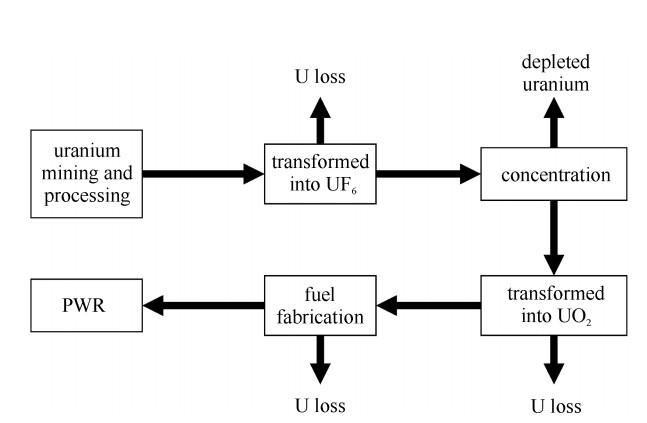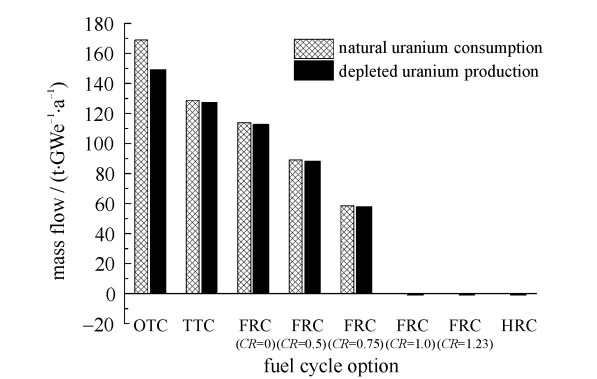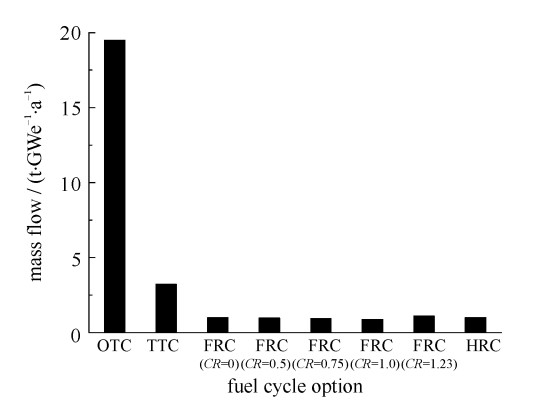Sustainability and economy analysis of different fuel cycle options
-
摘要: 基于核燃料循环政策技术的成熟度,选取了一次通过循环方案(OTC)、单次复用循环方案(TTC)、快堆闭式循环方案(FRC)及混合堆闭式循环方案(HRC)四种典型的核燃料循环方案进行分析。采用平衡物质流模型对不同燃料循环方案的可持续性进行研究,基于平准化电力成本计算方法对不同方案的燃料成本和乏燃料处置成本进行分析。研究结果表明:闭式燃料循环可极大减少核废料产生; 燃料可自持的FRC方案及HRC方案可使用贫铀做燃料而不消耗天然铀; 仅考虑燃料成本和乏燃料处置成本时,HRC方案的经济性最高而TTC方案的经济性最差。Abstract: Based on the technology maturity, four typical nuclear fuel cycle options, namely, OTC, TTC, FRC and HRC, were selected for analysis. The sustainability of different fuel cycle options was studied using the balanced mass flow model, and the fuel cost and spent fuel disposal cost of different options were evaluated based on levelized cost of electricity calculation method. The results show that closed fuel cycle can greatly reduce the production of nuclear waste. And the FRC option with fuel self-supporting as well as the HRC option can use depleted uranium without consuming natural uranium. Besides, the HRC option is the most economical while the TTC option is the worst, considering only fuel cost and spent fuel disposal cost.
-
Key words:
- fuel cycle /
- balanced mass flow /
- sustainability /
- levelized cost of electricity /
- economy
-
表 1 轻水反应堆装料质量流
Table 1. Light water reactor loading mass flow
nuclide mass flow/(MTHM·GWe-1·a-1) PWR UO2 PWR MOX/UO2 load after cooling load after cooling MOX UO2 MOX UO2 HM 19.5 18.494 5.719 13.667 5.425 12.964 U(235U) 19.500(0.825) 18.244(0.150) 5.22 13.667 5.041 12.788 Pu 0 0.225 0.491 0 0.343 0.157 MA 0 0.025 0.008 0 0.04 0.02 TRU 0 0.25 0.499 0 0.383 0.177 FP 0 1.006 0 0 0.293 0.703 表 2 快堆装料质量流
Table 2. Fast reactor loading mass flow
nuclide mass flow/(MTHM·GWe-1·a-1) fast breeder reactor fast burner reactor CR=1.23 CR=0 CR=0.5 CR=0.75 CR=1 load after cooling load after cooling load after cooling load after cooling load after cooling HM 14.84 14.01 2.78 1.906 6.194 5.324 8.203 7.327 11.19 10.34 TRU 1.287 1.507 2.741 1.866 2.064 1.667 1.74 1.575 1.552 1.571 U 13.52 12.47 0.039 0.04 4.13 3.647 6.463 5.752 9.64 8.763 FP 0 0.831 0 0.874 0 0.87 0 0.876 0 0.857 Pu 1.287 1.507 - - - - - - - - 表 3 前端燃料单元的价格
Table 3. Price of units of front-end fuel
unit reference value/($·kgHM-1) natural uranium 100 depleted uranium 10 conversion 10a concentration 140b UOX fabrication 258c MOX fabrication 2 400 fabrication of fast reactor fuel 2 400 fabrication of hybrid reactor fuel 30d Notes:
a:The conversion price of recycled uranium is about 300% of that of the natural uranium;
b:The enrichment price of recycled uranium is about 110% of that of the natural uranium;
c:The manufacturing price of REPUOX fuel is about 107% of that of the natural uranium;
d:The fuel for the hybrid reactor is a plate structure and requires no fine processing, so the manufacturing cost is low, but there was no mature technology. Referring to the conversion process of recycled uranium, the manufacturing cost of the hybrid reactor fuel was set to 30 $·kgHM-1.表 4 燃料处置单元的价格
Table 4. Price of units of fuel disposal
unit reference value/($·kgHM-1) UOX temporary storage 200 MOX temporary storage 200 UOX spent fuel disposal 412 MOX spent fuel disposal 3 130 UOX HLW 190 fast reactor HLW 280 UOX reprocess 1 600 fast reactor fuel reprocess 3 200 simple dry processing 120a Notes:
a:The cost of fuel temporary cooling and storage was included in the cost of fuel reprocessing. The hybrid reactor fuel was reprocessed every five years by the simple dry process, to remove the fission products of spent fuel using the decay heat. The process was simple and required little cost, but there was no mature technology. Referring to the price of dry storage in EPRI, the price of simple dry process was set to 120 $·kgHM-1 -
[1] 张小锋, 张斌. 我国中长期能源碳排放情景展望[J]. 中国能源, 2016, 38(2): 38-42. https://www.cnki.com.cn/Article/CJFDTOTAL-ZGLN201602012.htmZhang Xiaofeng, Zhang Bin. China's long-term energy carbon emission outlook. Energy of China, 2016, 38(2): 38-42 https://www.cnki.com.cn/Article/CJFDTOTAL-ZGLN201602012.htm [2] Deutch J, Driscoll M, Gray P E, et al. The future of nuclear power: An interdisciplinary MIT study[R]. 0-615-12420-8, 2003. [3] Bunn M, Holdren J P, Fetter S, et al. The economics of reprocessing versus direct disposal of spent nuclear fuel[J]. Nuclear Technology, 2005, 150(3): 209-230. doi: 10.13182/NT05-A3618 [4] Suzuki T. The fast reactor and its fuel cycle developments in Japan: Can Japan unlock its development path?[J]. Science and Global Security, 2009, 17(1): 68-76. doi: 10.1080/08929880902953039 [5] OECD/NEA. The economics of the nuclear fuel cycle[R]. 1990066X, 1994. [6] 徐銤. 快堆和我国核能的可持续发展[J]. 现代电力, 2006, 2(5): 106-110. https://www.cnki.com.cn/Article/CJFDTOTAL-XDDL200605012.htmXu Mi. The sustainable development of fast reactor and nuclear energy in China. Modern Electric Power, 2006, 2(5): 106-110 https://www.cnki.com.cn/Article/CJFDTOTAL-XDDL200605012.htm [7] 张建平, 王琳. 我国两种核燃料循环方案的经济分析与评价[J]. 中外能源, 2015, 20(6): 35-41. https://www.cnki.com.cn/Article/CJFDTOTAL-SYZW201506006.htmZhang Jianping, Wang lin. Economic analysis and evaluation of two nuclear fuel cycle options in China. Sino-Global Energy, 2015, 20(6): 35-41 https://www.cnki.com.cn/Article/CJFDTOTAL-SYZW201506006.htm [8] 刘国明, 邵增. 混合能源堆裂变包层核燃料成本分析[J]. 核科学与工程, 2017, 37(1): 154-160. https://www.cnki.com.cn/Article/CJFDTOTAL-HKXY201701025.htmLiu Guoming, Shao Zeng. Fuel cost analysis for fission layer of fusion-fission hybrid reactor for energy. Nuclear Science and Engineering, 2017, 37(1): 154-160 https://www.cnki.com.cn/Article/CJFDTOTAL-HKXY201701025.htm [9] 丁晓明. 从不同燃料循环模式分析快堆燃料循环的经济性[J]. 中国核电, 2014, 7(2): 160-167. https://www.cnki.com.cn/Article/CJFDTOTAL-ZGHD201402018.htmDing Xiaoming. Economic analysis of fast reactor fuel cycle with different modes. China Nuclear Power, 2014, 7(2): 160-167 https://www.cnki.com.cn/Article/CJFDTOTAL-ZGHD201402018.htm [10] 彭先觉, 王真. Z箍缩驱动聚变-裂变混合能源堆总体概念研究[J]. 强激光与粒子束, 2014, 26: 090201. doi: 10.11884/HPLPB201426.090201Peng Xianjue, Wang Zhen. Conceptual research on Z-pinch driven fusion-fission hybrid reactor. High Power Laser and Particle Beams, 2014, 26: 090201 doi: 10.11884/HPLPB201426.090201 [11] 师学明. 聚变裂变混合能源堆包层中子学概念研究[D]. 绵阳: 中国工程物理研究院, 2010.Shi Xueming. Study on the neutrons concept of the fusion-fission hybrid reactor blanket. Mianyang: China Academy of Engineering Physics, 2010 [12] De Roo G. Economics of nuclear fuel cycles : Option valuation and neutronics simulation of mixed oxide fuels[R]. MIT-635981218, 2009. [13] Hoffman E A, Hill R N, Taiwo T A. Advanced LWR multi-recycle concepts[J]. Transactions of the American Nuclear Society, 2005, 93(13): 363-364. [14] Quinn J E, Magee P M, Thompson M L, et al. ALMR fuel cycle flexibility[C]//Proceedings of the American Power Conference. 1993, 55(2): 1079-1084. [15] Hoffman E A, Yang W S, Hill R N. Preliminary core design studies for the advanced burner reactor over a wide range of conversion ratios[R]. ANL-AFCI-177, 2008. [16] MIT. The future of the nuclear fuel cycle[R]. 978-0-9828008-4-3, 2011. [17] Hamel J. An economic analysis of select fuel cycles using the steady-state analysis model for advanced fuel cycles schemes (SMAFS)[R]. EPRI-1015387, 2007. -





 下载:
下载:




